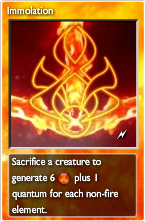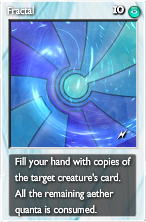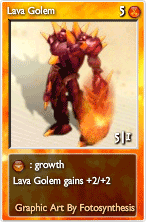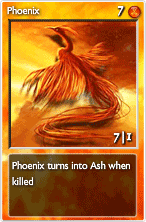Phoenix
|
|
Contents
Artist's Comment
"The art that started it all, really. In the same contest that spawned Crusader, Ohmega asked me to make some art for his card idea, Phoenix. As a chance to play with bright colors, I added my art to his idea.. And before the contest even ended, I was contacted by zanzarino, asking me to use my art on a similar concept in-game. This was the start of my help with Elements, and I'd say it was a pretty good start at that!" -vrt
Overview
Like all Fire creatures, the Phoenix is a "glass cannon" creature with high ATK but a very fragile amount of HP. However, Phoenix is extremely hard to get rid of. When killed, Phoenix will turn into Ash, a residual 0|5 creature that can be reborn into a new Phoenix for 1 ![]() quanta.
quanta.
General Use
Quick Facts:
- Phoenix turns into Ash if it's killed, and Ash can turn back into Phoenix for 1
 .
. - To truly kill a Phoenix, players must either remove the 'Phoenix' ability via Lobotomy, or kill the subsequent Ash that is left over upon killing the Phoenix creature.
- A player can revive a Phoenix the following turn if they kill it. If the enemy kills it first however, the player must wait 2 turns before reviving the Ash.
- Aflatoxin will still turn the Phoenix into a Malignant Cell upon death.
With only 1 HP, Phoenix seems to be extremely vulnerable to creature control, and any damaging effect can instantly crush this bird into a pile of ash. But just like the phoenix in folklore, the Ash left behind by this creature's death can be reborn into another Phoenix by paying 1 ![]() . This makes Phoenix extremely hard to kill, because Ash has no attack power but it has 5 HP, making it very difficult to kill it in just one turn (excluding the use of Lightning) before it revives into a Phoenix. However, if Phoenix or Ash is lobotomized, it can no longer be reborn or revived; removing its ability is a more efficient way to make sure Phoenix stays dead.
. This makes Phoenix extremely hard to kill, because Ash has no attack power but it has 5 HP, making it very difficult to kill it in just one turn (excluding the use of Lightning) before it revives into a Phoenix. However, if Phoenix or Ash is lobotomized, it can no longer be reborn or revived; removing its ability is a more efficient way to make sure Phoenix stays dead.
It should be clarified that when a Phoenix is killed, the resultant Ash is summoned to the field as a new creature, so any statuses the Phoenix previously had are gone. However, when a player activates Ash's ability and turns it into a Phoenix, it is considered an evolution, so all statuses the Ash previously had will be transferred to the Phoenix. Also, Ash is not a standalone card. It cannot be bought from the bazaar, or won from the slot machine; the only way to obtain Ash is by killing a Phoenix.
Synergies
 Because of its cycle of endless death and rebirth, Phoenix is often used as a renewable Immolation | Cremation fuel. Immolation can instantly generate a large amount of Fire quanta; but with Phoenix, the deal is even better, as the player can immediately revive their Phoenix on the next turn after they Immolate it. This makes Phoenix a very nice addition to pillarless Immolation speed decks, using spells and creatures to generate the necessary quanta instead of pillars. Phoenix can also be used to exploit certain Death cards such as Boneyard and Bone Wall, since killing a Phoenix is considered a creature death even when it is reborn into Ash.
Because of its cycle of endless death and rebirth, Phoenix is often used as a renewable Immolation | Cremation fuel. Immolation can instantly generate a large amount of Fire quanta; but with Phoenix, the deal is even better, as the player can immediately revive their Phoenix on the next turn after they Immolate it. This makes Phoenix a very nice addition to pillarless Immolation speed decks, using spells and creatures to generate the necessary quanta instead of pillars. Phoenix can also be used to exploit certain Death cards such as Boneyard and Bone Wall, since killing a Phoenix is considered a creature death even when it is reborn into Ash.
 Phoenix is a 7|1 creature for 7
Phoenix is a 7|1 creature for 7 ![]() ; the upgrade is a Minor Phoenix, a 4|1 creature for 2
; the upgrade is a Minor Phoenix, a 4|1 creature for 2 ![]() . At first glance, it would seem that Phoenix has become weaker after the upgrade, having its ATK almost halved. However, the summoning cost of Phoenix is reduced to little more than a quarter of its original cost; upon closer inspection, players can see that the damage-to-cost ratio is doubled after the upgrade. More importantly, a cost of 2
. At first glance, it would seem that Phoenix has become weaker after the upgrade, having its ATK almost halved. However, the summoning cost of Phoenix is reduced to little more than a quarter of its original cost; upon closer inspection, players can see that the damage-to-cost ratio is doubled after the upgrade. More importantly, a cost of 2 ![]() means that one can summon Minor Phoenix on turn one or turn two, making it extremely efficient in speed decks. The extremely low summoning cost also means that Phoenix can be targeted by Fractal | Fractal, allowing players to summon multiple Minor Phoenixes all at once. This deck, also known as a 'Fractal Phoenix' deck, is incredibly fast and difficult to deal with due to the speed and durability of the Minor Phoenixes that enter the field at once.
means that one can summon Minor Phoenix on turn one or turn two, making it extremely efficient in speed decks. The extremely low summoning cost also means that Phoenix can be targeted by Fractal | Fractal, allowing players to summon multiple Minor Phoenixes all at once. This deck, also known as a 'Fractal Phoenix' deck, is incredibly fast and difficult to deal with due to the speed and durability of the Minor Phoenixes that enter the field at once.
 In many Fire-based rush decks, Lava Golem | Lava Destroyer and the Phoenix are practically two symbiotic cards; both of them having been used together so easily due to their relative ease in utilization. While Phoenixes provide durable damage, the Golems can provide growing damage given enough
In many Fire-based rush decks, Lava Golem | Lava Destroyer and the Phoenix are practically two symbiotic cards; both of them having been used together so easily due to their relative ease in utilization. While Phoenixes provide durable damage, the Golems can provide growing damage given enough ![]() quanta, and with time, can become resistant to many forms of CC once their HP is high enough. The Golem's effectiveness is well-known in many Phoenix decks, and is one of the most popular creature (and card in general) to support the Phoenix in any deck.
quanta, and with time, can become resistant to many forms of CC once their HP is high enough. The Golem's effectiveness is well-known in many Phoenix decks, and is one of the most popular creature (and card in general) to support the Phoenix in any deck.
Other Cards With Synergy
Various other Fire creatures, such as Seraph and Crimson Dragon (both, which are airborne) can be used alongside the Phoenix for major burst damage when needed, especially if the user has an excess of ![]() quanta in store. Should Seraph or the Dragon be used, Shard of Freedom becomes a rare but unique choice to add in the mix, as it can add major damage and bypass shields without the use of PC. Otherwise, handy Fire cards such as Deflagration (for shields) and Rage Potion (for tricky enemy creatures) can also be useful. Given the use of Immolation, players can also use Graboids for a safer damage alternative against AI opponents, in case the Pheonix is taken out (the
quanta in store. Should Seraph or the Dragon be used, Shard of Freedom becomes a rare but unique choice to add in the mix, as it can add major damage and bypass shields without the use of PC. Otherwise, handy Fire cards such as Deflagration (for shields) and Rage Potion (for tricky enemy creatures) can also be useful. Given the use of Immolation, players can also use Graboids for a safer damage alternative against AI opponents, in case the Pheonix is taken out (the ![]() quanta will be used for the Evolve ability, providing extra damage).
quanta will be used for the Evolve ability, providing extra damage).
Conclusion
Phoenix is a true idol of the Fire element, representing its power, determination, and surprising speed in a variety of situations. Given its ability to rise up to the occasion (or from the dead), any elemental doubtful of its strength can be easily taught their lesson with a quick game over screen by the mythological bird of rebirth.
Popular Deck
Phoenixplosion! Quite Literally!

7dm 7dm 7dp 7dp 7dp 7dp 7dp 7ds 7ds 7ds 7ds 7ds 7ds 7f2 7f2 7f2 7f2 7f2 7f2 7f2 808 808 808 809 809 80i 80i 80i 80i 80i 8pu

